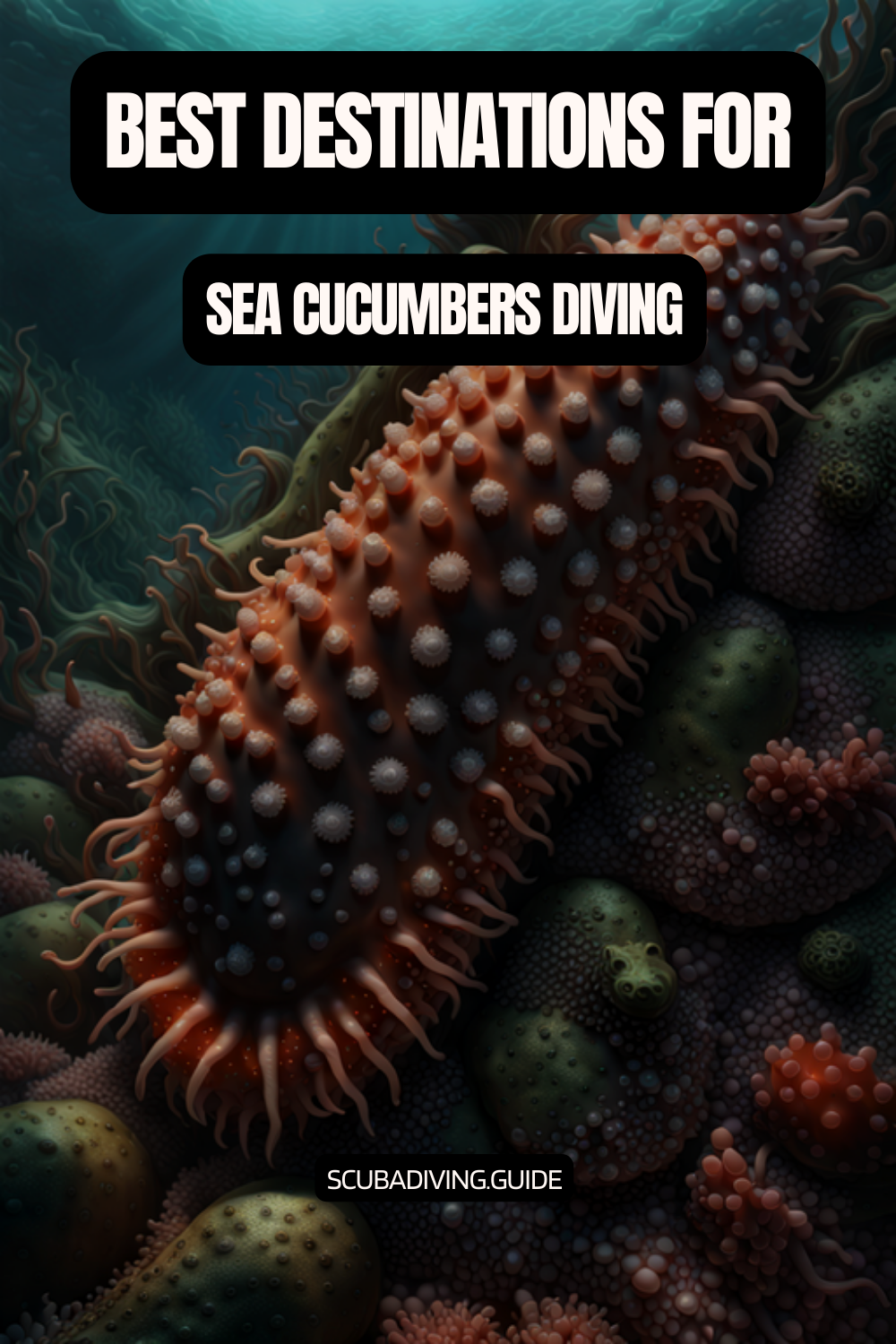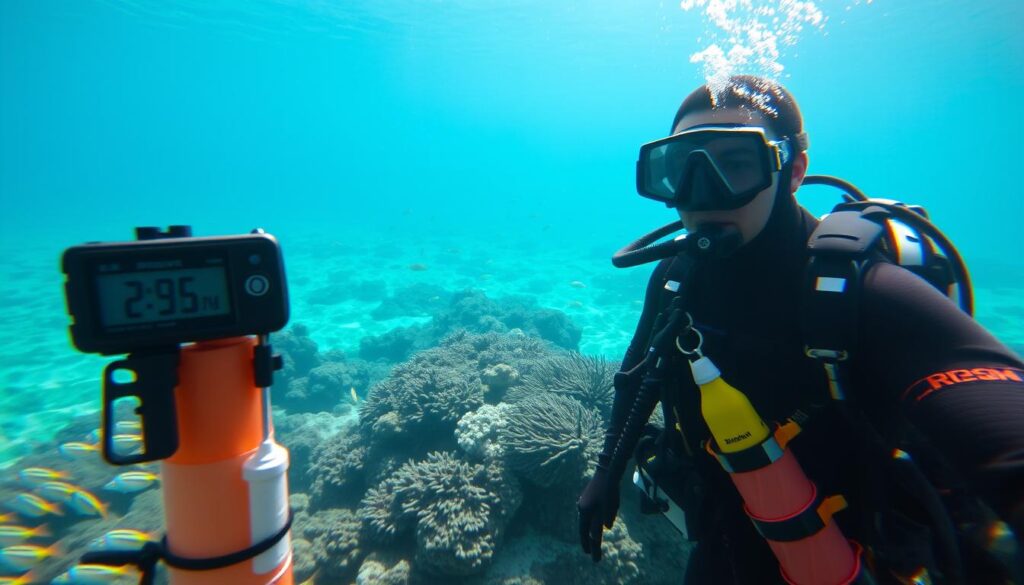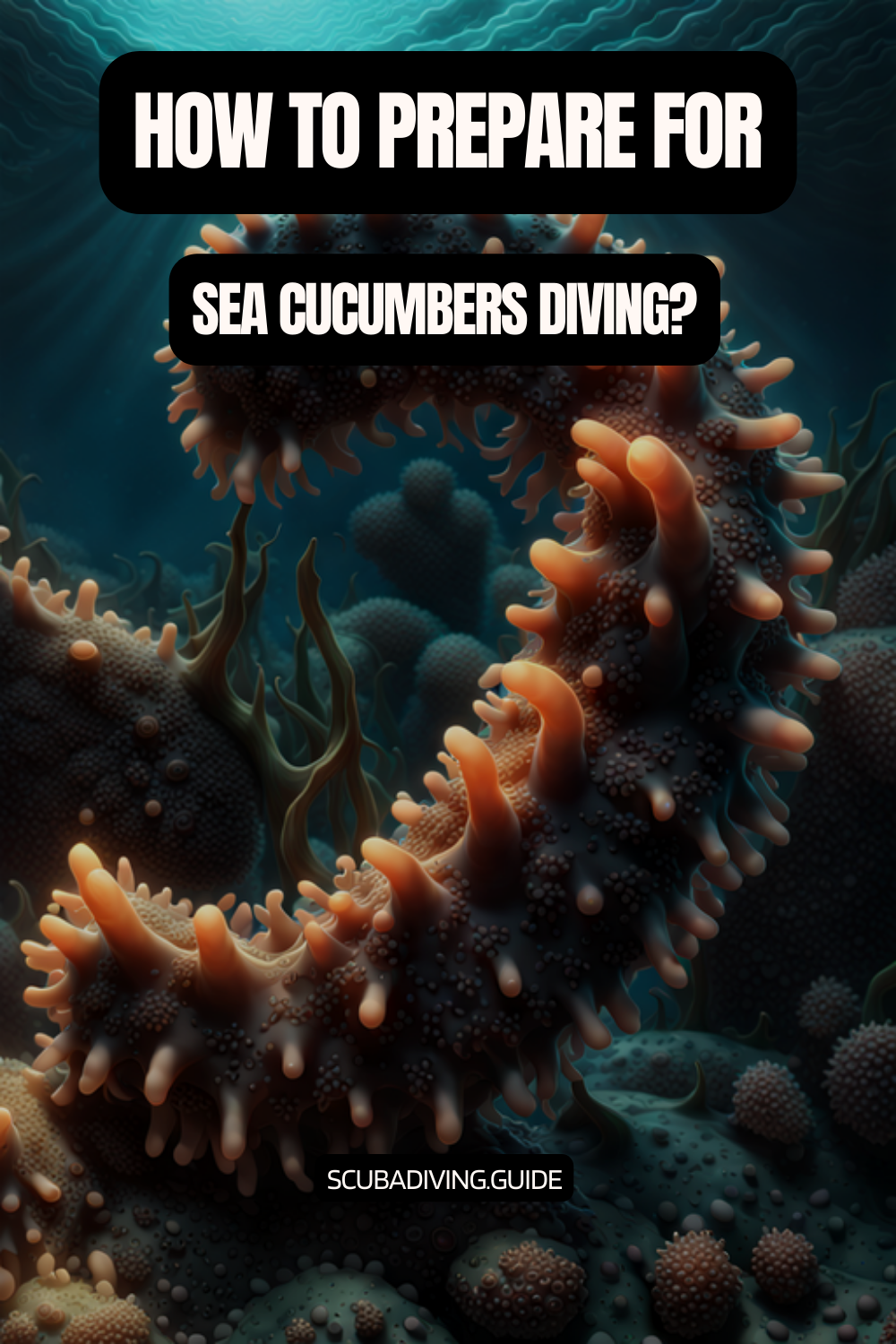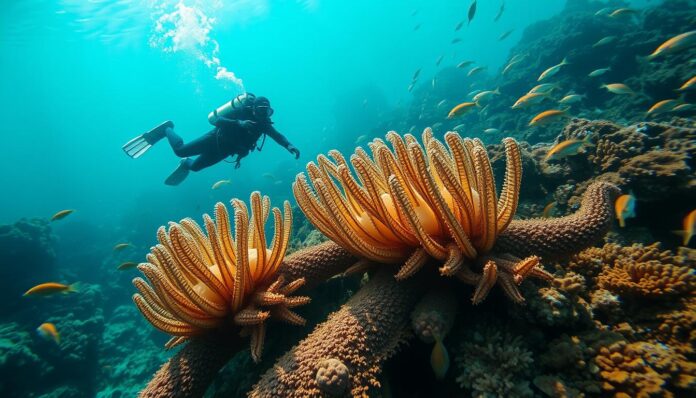Imagine diving into an underwater world where a single sea cucumber can filter 31 pounds of sand annually. They are nature’s own marine cleaning crew! Scuba diving with sea cucumbers gives us a unique look at these fascinating creatures. They have been around for over 450 million years, living in both shallow and deep waters.
Marine biology fans and underwater photography enthusiasts will love sea cucumbers. There are over 1,700 known species, ranging from tiny to as long as a human. They are important in marine ecosystems, filtering sand and processing ocean waste.
Scuba diving lets us see these amazing animals in their natural home. Their unique features and roles in the ocean are truly fascinating. Sea cucumbers show us the beauty and diversity of marine life.
Key Takeaways
- Sea cucumbers have existed for over 450 million years
- More than 1,700 species exist worldwide
- They play a critical role in marine ecosystem maintenance
- Size varies from less than 1 inch to human length
- Underwater photography offers unique documentation opportunities
Introduction to Sea Cucumbers and Scuba Diving
Dive into the fascinating world of exotic marine life as we explore the remarkable sea cucumbers. These unique creatures are more than just another marine organism. They are critical players in ocean ecosystems and a spectacular highlight for eco-tourism enthusiasts.
Sea cucumbers are an extraordinary group of marine animals. They play a vital role in sustainable tourism and ocean conservation. With 1,717 recorded species worldwide, these fascinating echinoderms range from tiny 3.9-inch creatures to impressive 8-foot giants found in diverse marine environments.
What Are Sea Cucumbers?
Sea cucumbers are marine invertebrates belonging to the echinoderm family. They are closely related to starfish and sea urchins. Their distinctive characteristics include:
- Ability to breathe through their rear ends
- Capacity to expel internal organs as a defense mechanism
- Remarkable regeneration skills
“Sea cucumbers are nature’s underwater recyclers, maintaining the delicate balance of marine ecosystems.”
Importance of Sea Cucumbers in Marine Ecosystems
These marine creatures are critical decomposers. They help maintain nutrient balance in ocean environments. Their ecological significance includes:
- Bioturbating ocean floors
- Recycling marine nutrients
- Supporting coral reef health
Scuba divers interested in eco-tourism can appreciate sea cucumbers. They are living indicators of marine ecosystem well-being. By observing these remarkable creatures, divers contribute to conservation awareness and sustainable tourism practices.
| Sea Cucumber Characteristics | Details |
|---|---|
| Total Species | 1,717 worldwide |
| Average Length | 3.9 – 12 inches |
| Regeneration Time | Less than 5 weeks |
Understanding sea cucumbers offers a window into the complex and interconnected world of marine life. They are a fascinating subject for sustainable tourism and marine conservation efforts.
Getting Started: Essential Gear for Scuba Diving
When you’re ready to dive with sea cucumbers, picking the right gear is key. The right equipment makes your snorkeling and diving safe and fun.
Choosing the best diving gear means knowing what you need and where you’ll dive. This helps you pick the right stuff for scuba diving with sea cucumbers.
Must-Have Equipment for Beginners
Every new diver needs reliable gear. Here’s what you should have in your diving kit:
- Mask with anti-fog coating
- Open-heel fins with adjustable straps
- Dive computer for safety monitoring
- Underwater communication device
- Depth and pressure gauges
Pro tip: Local surf shops can give you great advice on gear. 90% of divers say getting help from pros is a must.
Choosing the Right Wetsuit
Your wetsuit keeps you safe underwater. Think about these things when picking one:
| Wetsuit Type | Best For | Temperature Range |
|---|---|---|
| Thin Suit (3mm) | Tropical Waters | 75-85°F |
| Medium Suit (5mm) | Temperate Regions | 60-75°F |
| Thick Suit (7mm) | Cold Water Diving | Below 60°F |
“The right equipment can turn a simple dive into an extraordinary underwater journey.” – Marine Exploration Society
For snorkeling and diving with sea cucumbers, get top-notch, comfy gear. It lets you explore the sea safely and with confidence.
Best Locations for Scuba Diving with Sea Cucumbers
Ocean exploration opens up a world full of marine life. Sea cucumbers live in many places around the world. Scuba diving fans can find these creatures in amazing spots.
Eco-tourism lets us see sea cucumbers in their homes. The Holothuriidae family has about 185 species. This means divers can have exciting meetings with them in different sea places.
Top Dive Spots Worldwide
Asia:
- Indonesia: The Indonesian archipelago is home to a rich variety of sea cucumber species. Destinations like Raja Ampat, Komodo National Park, and the Bunaken Marine Park offer exceptional diving opportunities to encounter sea cucumbers amidst vibrant coral reefs and diverse marine life.
- Philippines: With its stunning coral reefs and abundant marine biodiversity, the Philippines is a haven for sea cucumber diving. Popular sites such as Apo Island, Tubbataha Reefs Natural Park, and Anilao showcase the beauty of sea cucumbers in their natural habitats.
- Malaysia: The waters of Malaysia are teeming with marine life, including sea cucumbers. Sipadan Island, Mabul Island, and the Tunku Abdul Rahman Marine Park are renowned dive destinations where you can immerse yourself in the wonders of sea cucumber encounters.
- Egypt: The Red Sea off the coast of Egypt offers excellent diving opportunities to explore sea cucumber habitats. Dahab, Sharm El Sheikh, and Hurghada are popular dive destinations known for their diverse marine life, including sea cucumbers.
- Mozambique: With its pristine coral reefs and crystal-clear waters, Mozambique is a hidden gem for sea cucumber diving. Destinations like Tofo Beach and the Bazaruto Archipelago provide opportunities to encounter these intriguing creatures amidst breathtaking underwater landscapes.
- Bonaire: Located in the Dutch Caribbean, Bonaire is renowned for its protected marine parks and exceptional diving. The island’s fringing reefs are home to an abundance of sea cucumbers, making it an ideal destination for sea cucumber enthusiasts.
- Cayman Islands: The Cayman Islands offer a unique diving experience with their diverse marine life, including sea cucumbers. Grand Cayman, Cayman Brac, and Little Cayman provide opportunities to explore pristine reefs and encounter these fascinating creatures.
- Belize: The Belize Barrier Reef Reserve System, a UNESCO World Heritage site, is a paradise for sea cucumber diving. Destinations like the Great Blue Hole, Turneffe Atoll, and the Hol Chan Marine Reserve offer unforgettable encounters with sea cucumbers and other marine species.
- Honduras: The Bay Islands of Honduras, including Roatan, Utila, and Guanaja, boast vibrant coral reefs where sea cucumbers can be found. These destinations offer a combination of easy diving conditions, breathtaking seascapes, and diverse marine life.
- Greece: The waters surrounding the Greek islands are home to a variety of sea cucumber species. Destinations like Crete, Santorini, and Zakynthos offer opportunities to explore sea cucumber habitats while enjoying the rich history and culture of Greece.
- Australia: The Great Barrier Reef, stretching along the northeastern coast of Australia, is a world-renowned destination for diving with sea cucumbers. Cairns, the Whitsunday Islands, and the Ribbon Reefs are popular starting points to discover the remarkable biodiversity that includes these intriguing creatures.
- Mexico: Mexico offers exceptional diving experiences in the Caribbean Sea and the Pacific Ocean. Cozumel, Cancun, and the Socorro Islands are renowned for their sea cucumber populations, along with an array of other marine species.
- Canada: The cold waters of Canada’s Pacific coast, particularly in British Columbia, provide unique opportunities for diving with sea cucumbers. Areas such as the Barkley Sound and the Southern Gulf Islands are known for their diverse marine life, including colorful sea cucumbers.
- Ecuador: The Galapagos Islands, a UNESCO World Heritage site, are an incredible destination for diving with sea cucumbers. Encounter unique species like the Galapagos sea cucumber while exploring the pristine waters of this iconic archipelago.
- Venezuela: Los Roques Archipelago National Park in Venezuela is a hidden gem for sea cucumber diving. Its clear waters, vibrant coral reefs, and rich biodiversity make it an excellent destination for underwater exploration.
These destinations offer extraordinary opportunities to dive with sea cucumbers, providing a glimpse into the remarkable diversity of marine life around the world. Whether you choose the azure waters of the Caribbean, the coral reefs of the Indo-Pacific, or the captivating ecosystems of other regions, diving with sea cucumbers is sure to leave you with unforgettable memories of the underwater realm.

Seasonal Considerations for Divers
“Knowing when to dive is key for seeing sea cucumbers.”
Research shows important times for diving with sea cucumbers:
- October-December: Best times to dive
- Feeding at night in certain months
- Water temperature affects seeing them
Planning dives for the right seasons helps see sea cucumbers better. This makes ocean adventures even more exciting.
Understanding Sea Cucumber Behavior
Diving into marine biology shows us the amazing world of sea cucumbers. These creatures live in different parts of the ocean. They have survival strategies that amaze scientists.
Remarkable Feeding Mechanisms
Sea cucumbers have unique ways of eating. They are important in the ocean’s food chain. Here’s how they eat:
- Ingesting marine sediment
- Filtering out organic matter
- Processing nutrients through specialized digestive systems
Extraordinary Survival Adaptations
Sea cucumbers have amazing ways to survive. They stand out in the ocean. Some of their cool survival tricks are:
- Organ Expulsion Defense: They can throw out their insides to distract predators
- They can quickly grow back their organs
- They can change from soft to hard
“Sea cucumbers show nature’s incredible survival skills through clever biology.” – Marine Biology Research Institute
Scientists say sea cucumbers can make up to 95% of the big animals in deep-sea areas. With about 900 species, they keep scientists interested in ocean exploration and marine life.
The Role of Sea Cucumbers in the Ocean
Sea cucumbers are unsung heroes of marine biology. They play a critical role in keeping ocean ecosystems balanced. These creatures are more than just strange-looking marine invertebrates. They are essential for coral reef health and marine conservation efforts.
Marine biologists have found out how important sea cucumbers are. They are key in nutrient recycling and support sustainable tourism in marine environments.
Nutrient Recycling Mechanisms
Sea cucumbers have unique ways of recycling nutrients in ocean ecosystems:
- Reduce sediment mass on corals by over 60%
- Remove harmful sediments from reef environments
- Help maintain water quality through continuous feeding
Supporting Coral Reef Ecosystems
The relationship between sea cucumbers and coral reefs is symbiotic and very important. Research shows that coral colonies with sea cucumbers are much healthier.
“Sea cucumbers provide ecological insurance for marine ecosystems, helping to protect and sustain coral reef biodiversity.”
| Ecosystem Impact | Percentage/Statistic |
|---|---|
| Coral organisms supported | 25% of marine life |
| Coral disease reduction | 15x less likely with sea cucumbers |
| Sediment reduction | Over 60% improvement |
Conservation efforts are key to protect these marine guardians. By understanding their role in sustainable tourism and marine biology, we can preserve these incredible creatures and the ecosystems they support.
Safety Precautions While Diving
Scuba diving with sea cucumbers needs careful planning and awareness. The sea has its own dangers that we must respect and understand. Divers should always put their safety first while also caring for the ocean.

Keeping safe while diving is very important. It involves knowing the risks and how to avoid them. This way, diving can be both safe and fun.
Understanding Marine Environment Risks
Before diving into sea cucumber homes, we need to check the water. Important things to look at include:
- Water currents and temperature
- Depth variations
- Local marine life interactions
- Potential underwater hazards

Essential Safety Tips for Diving
To stay safe and protect the ocean, we must prepare well:
- Always dive with a certified partner
- Check equipment before entering water
- Maintain proper buoyancy control
- Use appropriate diving gear
| Diving Safety Metric | Recommended Practice |
|---|---|
| Dive Depth | 15-40 meters maximum |
| Buoyancy Control | Use control devices (only 5-10% of divers currently do) |
| Training | Certified instructor guidance |
“Safety in diving is not about eliminating risk, but managing it intelligently.” – Marine Exploration Expert
Responsible diving practices protect both divers and delicate marine ecosystems during sea cucumber encounters.
How to Interact Respectfully with Sea Cucumbers
Diving into the underwater world is more than just knowing how to dive. It’s about treating marine life with respect. Sea cucumbers are key to healthy oceans, so divers must handle them gently.
Eco-tourism means diving with care. Divers need to know how important sea cucumbers are to the ocean’s health. They live in special places that need our protection.
Best Practices for Divers
- Maintain a safe distance of at least 3-4 feet from sea cucumbers
- Never touch or remove sea cucumbers from their natural environment
- Use minimal lighting and avoid disturbing their habitat
- Observe quietly and minimize underwater movements
Recognizing Conservation Needs
The sea cucumber fishery is huge, with over 70 countries involved. Divers can help by:
- Reporting unusual habitat changes to marine research teams
- Participating in citizen science programs
- Supporting local marine protection initiatives
“Every dive is an opportunity to become a guardian of marine ecosystems.” – Marine Conservation Expert
By diving responsibly, we can protect sea cucumbers. This helps support sustainable tourism in our oceans.
Educational Opportunities: Learning About Sea Cucumbers
Diving into marine biology opens up exciting educational paths for those who love the ocean. Eco-tourism has changed how we interact with marine life. It gives us chances to learn about amazing creatures like sea cucumbers.
Now, marine researchers and dive operators offer detailed educational experiences. These programs turn casual divers into marine science fans. They connect fun diving with real scientific knowledge.
Guided Tours with Expert Insights
Marine biology tours offer deep learning about sea cucumbers. You can see marine worlds up close. And learn from experts who know a lot about sea cucumbers.
- Professional marine biologists lead immersive underwater tours
- Learn about sea cucumber behavior and ecosystem roles
- Gain hands-on research experience
Workshops and Certifications
Many places now have workshops and certification programs. They focus on watching and protecting marine life.
| Program Type | Duration | Focus Area |
|---|---|---|
| Marine Biology Certification | 6-12 months | Comprehensive marine ecosystem study |
| Sea Cucumber Research Workshop | 1-2 weeks | Specialized echinoderm research |
| Citizen Science Program | Ongoing | Community-based marine conservation |
“Every dive is an opportunity to learn and contribute to marine science.” – Dr. Annie Mercier
The IUCN SSC Sea Cucumber Specialist Group works in over 70 countries. It offers research and conservation chances for those who love the sea.
Cultural Significance of Sea Cucumbers
Sea cucumbers are a blend of exotic marine life, traditional practices, and ecological importance. They have been important in human cultures for centuries, mainly in Asian regions.

The importance of sea cucumbers goes beyond their marine home. They are key in traditional medicine and cooking, shaping how we interact with them.
Sea Cucumbers in Traditional Medicine
In many Asian cultures, sea cucumbers are seen as healing. Traditional healers use them for health treatments:
- Believed to support joint health
- Potential anti-inflammatory properties
- Used in treatments for digestive issues
- Considered a natural immune system booster
“Sea cucumbers represent nature’s pharmacy, bridging traditional wisdom with marine biodiversity.”
Culinary Traditions Across Cultures
Sea cucumbers are a prized dish in the culinary world, found in sustainable tourism spots. In China and other Asia-Pacific areas, they are made into delicious dishes. These dishes highlight their unique texture and nutritional benefits.
As demand for sea cucumbers grows, conservation efforts are key. It’s important to harvest them responsibly and support sustainable tourism. This helps protect these marine species from overfishing.
Despite their importance, sea cucumbers face challenges. It’s vital to balance cultural practices with conservation. This is essential for preserving marine ecosystems.
Conservation Efforts for Sea Cucumber Populations
Marine biology research shows big challenges for sea cucumber populations globally. These amazing sea creatures face threats that need urgent action to save them.
Sea cucumbers face many dangers that affect their survival and the health of their ecosystems:
- Extensive overfishing in many areas
- Habitat loss because of climate change
- Bad harvesting methods
- Little protection from laws
Current Threats to Sea Cucumber Survival
The sea cucumber world is under a lot of pressure from humans. It’s important to use sustainable tourism and conservation to protect these sea animals.
| Region | Key Challenges | Conservation Status |
|---|---|---|
| Papua New Guinea | Fishery collapse | Fishing ban from 2009-2017 |
| Washington State | Overharvesting | Quota-based management |
| Fiji | Undersized harvest | 50% juvenile population issues |
How Divers Can Contribute
Scuba divers are key in saving sea cucumbers. Responsible diving practices help a lot:
- Join citizen science projects
- Support marine protected areas
- Report on sea cucumber numbers
- Keep diving impacts low
“Every dive is an opportunity to become a guardian of marine ecosystems” – Marine Conservation Experts
Divers can use their knowledge to help protect sea cucumbers. This way, they can make tourism help marine conservation.
Common Marine Species Found Alongside Sea Cucumbers
Diving with sea cucumbers not only provides a fascinating experience with these unique organisms but also offers the opportunity to encounter a diverse array of marine life that coexists in their underwater habitats. From vibrant reef fish to intricate invertebrates, the presence of sea cucumbers often indicates a thriving ecosystem rich in biodiversity. Let’s explore some of the common marine species that can be found alongside sea cucumbers.
- Reef Fish: Reef fish add a vibrant burst of color to the underwater world. As you explore the seafloor, you may encounter species like angelfish, butterflyfish, parrotfish, and clownfish darting among the corals. These fish rely on the shelter and food sources provided by the reef ecosystem, often sharing the same habitats as sea cucumbers.
- Crustaceans: Crustaceans, such as colorful shrimps, lobsters, and crabs, are often found hiding among the crevices and corals near sea cucumbers. These fascinating creatures display a wide range of adaptations and behaviors, and observing their interactions with sea cucumbers can provide captivating insights into their symbiotic relationships.
- Echinoderms: Sea cucumbers are part of a larger group of marine animals known as echinoderms. Alongside sea cucumbers, you may encounter other echinoderms like sea stars, brittle stars, and sea urchins. These organisms play important roles in maintaining the ecological balance of the marine environment and contribute to the overall health of the ecosystem.
- Nudibranchs: Nudibranchs, or sea slugs, are a diverse group of gastropod mollusks that come in an astonishing variety of shapes, sizes, and colors. These delicate creatures are often found crawling near or on sea cucumbers, their vibrant patterns and intricate forms adding a touch of wonder to the underwater scenery.
- Sea Anemones: Sea anemones are stunning predatory animals that are often found attached to rocks or corals. They have a symbiotic relationship with certain species of clownfish, offering them protection while benefiting from their presence. Sea cucumbers may be found near sea anemones, sometimes seeking shelter or foraging in their vicinity.
- Sea Snakes: In some tropical regions, encounters with sea snakes are possible while diving with sea cucumbers. These graceful reptiles have evolved to live and hunt in the ocean and can be seen gliding through the water with their distinctive flattened tails. Although they are venomous, sea snakes are generally non-aggressive and pose minimal threat to divers if left undisturbed.
- Corals and Sponges: Sea cucumbers often inhabit coral reefs or areas with an abundance of corals and sponges. These organisms create intricate structures that provide homes and food sources for countless marine species. Observing the interactions between sea cucumbers and the various species of corals and sponges can provide a deeper understanding of the complex relationships within the ecosystem.
Encountering these common marine species alongside sea cucumbers adds to the overall richness and diversity of the underwater experience. Each organism has its own unique characteristics and ecological roles, contributing to the intricate web of life that thrives beneath the waves.
Conclusion: The Joy of Diving with Sea Cucumbers
Scuba diving with sea cucumbers opens a special window into the ocean’s life. These creatures are more than just sea animals. They are key to keeping the ocean healthy and offer great chances for underwater photos.
Sea cucumbers are facing big challenges, like the rise of fish farms. Divers are important in learning about and protecting these sea animals. By exploring the ocean responsibly, we can help people understand how vital sea cucumbers are.
Recap of Highlights
We’ve learned a lot about sea cucumbers, like how they help the ocean. They recycle nutrients and have clever ways to survive. Each fact shows us how important it is to save them and respect the ocean.
Encouragement to Explore Ocean Depths
Your photos can teach others about the sea. When you dive, you get to learn and help protect the ocean’s wonders. Enjoy the journey, care for the sea creatures, and keep learning about sea cucumbers and their role in our world.
FAQ – Diving with Sea Cucumbers
What are sea cucumbers, and why are they interesting to divers?
Sea cucumbers are fascinating creatures that live in the ocean. They can breathe through their rear ends and release their internal organs as a defense. Divers find them interesting because of their unique behaviors and the role they play in the ocean’s health.
Is it safe to get close to sea cucumbers while diving?
Sea cucumbers are mostly harmless, but it’s best to keep a safe distance. Some can release toxic substances when threatened. Always control your buoyancy and avoid touching them to protect both you and their homes.
What equipment do I need for diving with sea cucumbers?
You’ll need a good wetsuit, mask, fins, and scuba gear. An underwater camera is great for capturing their beauty. Make sure you can control your buoyancy to avoid harming the seafloor. A dive computer and proper weighting are also key for a safe dive.
Where are the best locations to see sea cucumbers while diving?
Great places include tropical coral reefs in Indonesia, the Philippines, and the Great Barrier Reef. The Pacific Northwest and parts of the Caribbean also have great sea cucumber sightings. Each spot offers different species and diving conditions.
How do sea cucumbers contribute to marine ecosystems?
Sea cucumbers are vital to the ocean’s health. They clean the ocean floor and recycle nutrients. This helps keep the water quality good, supports coral reefs, and is important in the food web.
Can I take photographs of sea cucumbers while diving?
Yes, underwater photography is a wonderful way to share your sea cucumber encounters. Use a camera with good macro capabilities. Follow responsible diving practices and avoid flash to not disturb them.
Are sea cucumbers endangered?
Many sea cucumber species are threatened by overfishing, habitat loss, and climate change. Some are already endangered. Divers can help by diving responsibly and supporting conservation efforts.
Do I need special training to dive with sea cucumbers?
No specific certification is needed, but advanced diving skills and buoyancy control are helpful. Consider guided tours with marine biologists or workshops on marine life observation and conservation.
How can I help conserve sea cucumber populations?
Support conservation by diving responsibly, joining citizen science programs, and spreading awareness. Avoid buying sea cucumber products and support marine protected areas. Choose eco-friendly tour operators that care about marine conservation.
Are sea cucumbers used in any cultural practices?
Sea cucumbers are important in Asian cuisines and traditional medicine. They’re seen as a delicacy and believed to have health benefits. But, this demand poses conservation challenges. Responsible tourism and awareness are key to protecting them.
